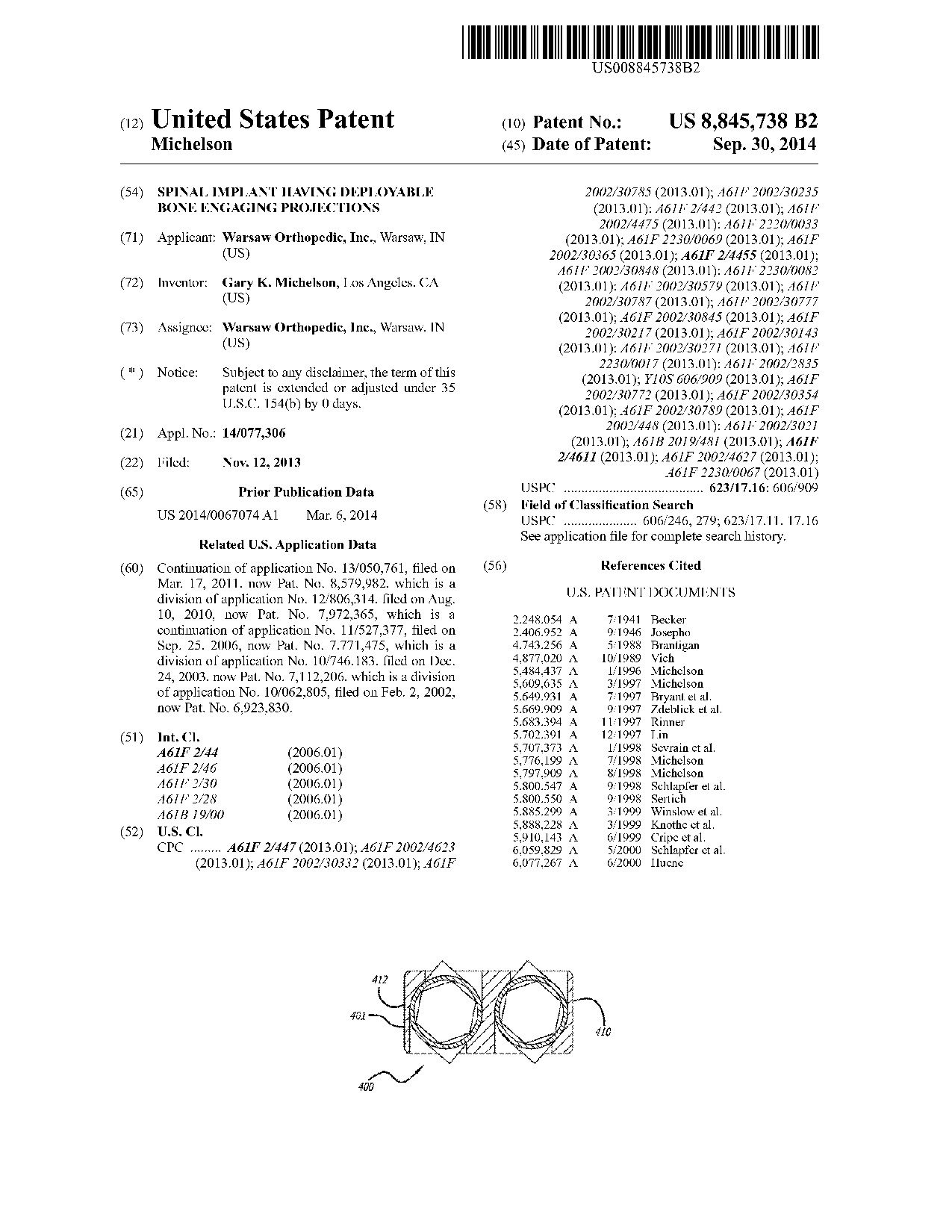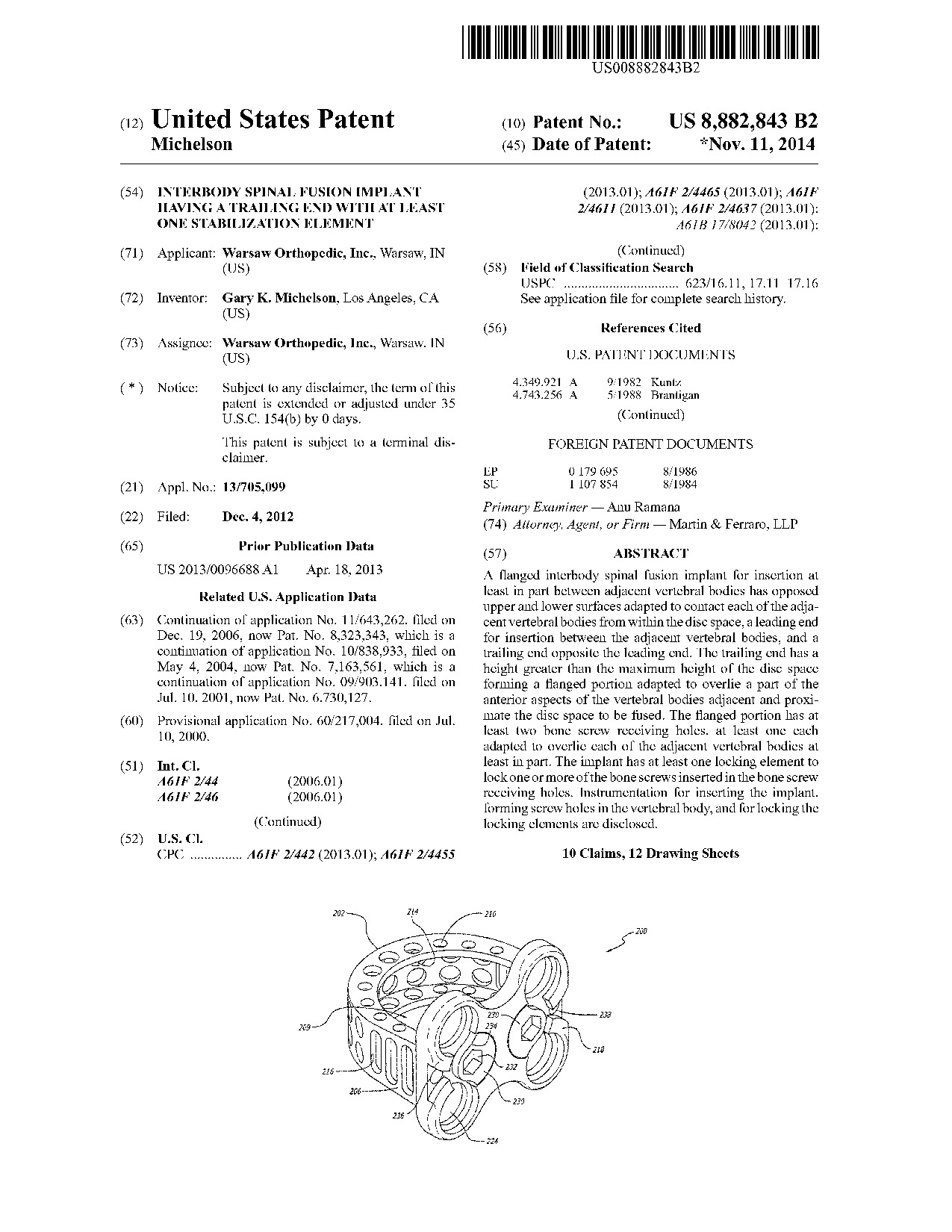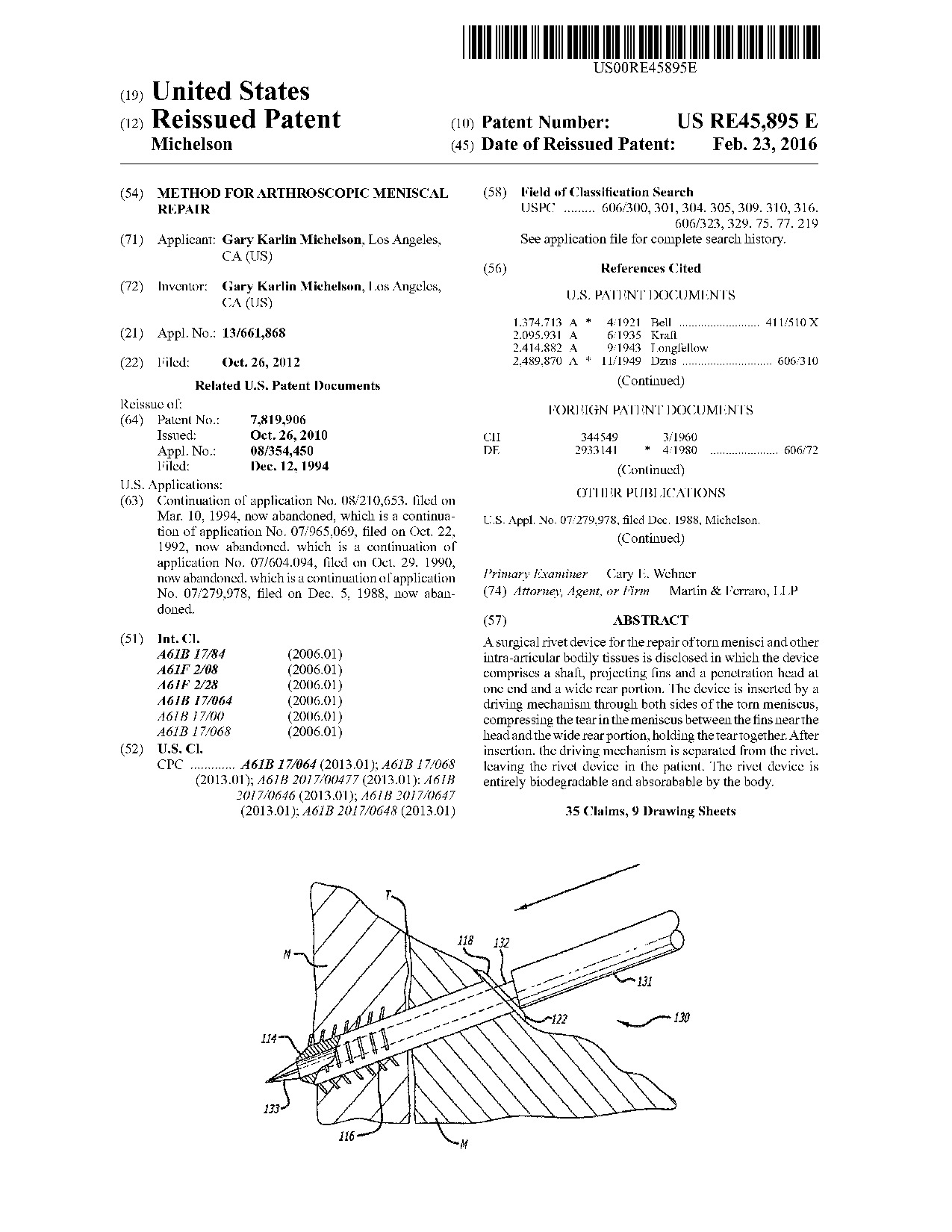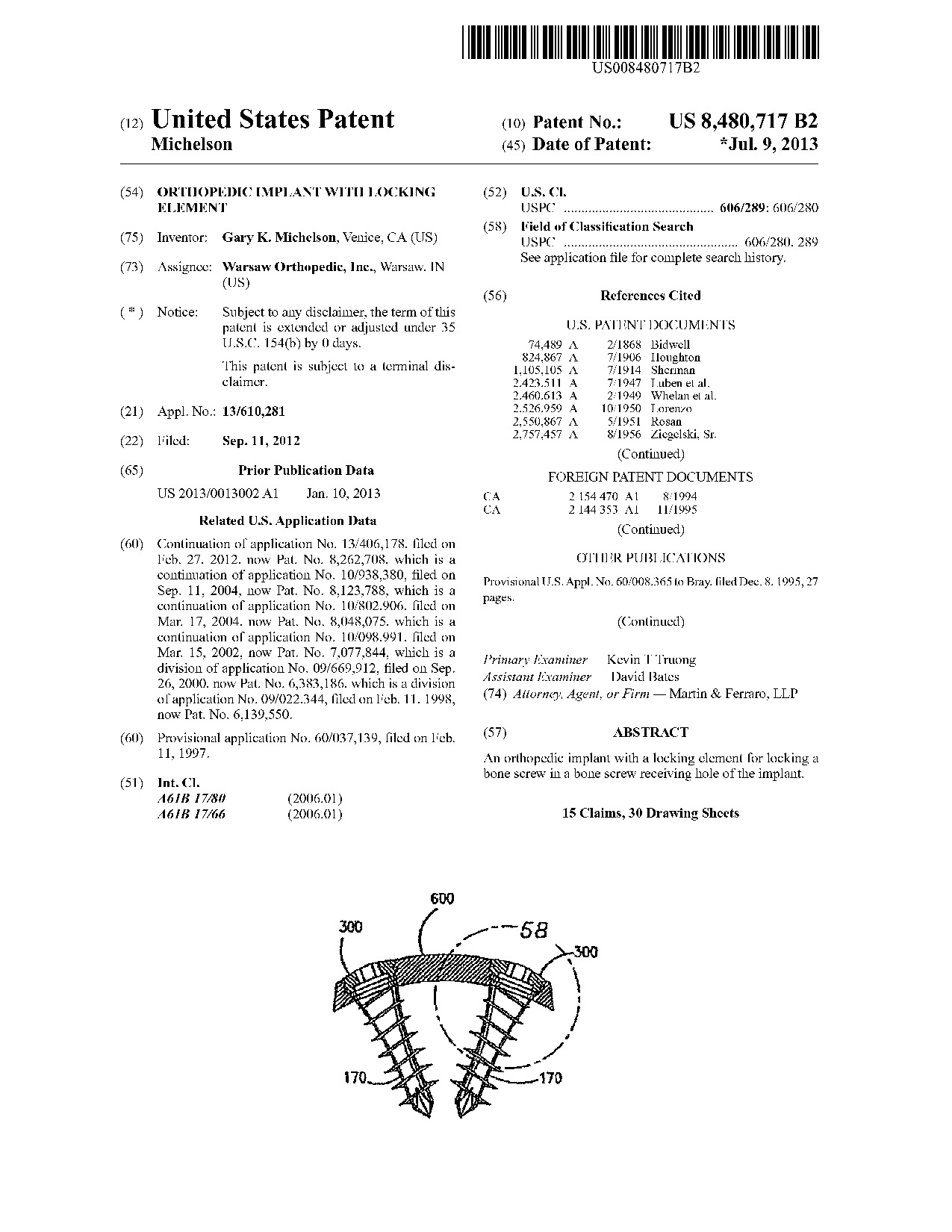Patents Directory for Dr. Gary K. Michelson — U.S. Published Patents only
340 patents found - Page 1
| Patent | Abstract |
|---|---|
 Method for using a guard for creating a socket posteriorly in the lumbar spine - Patent 9,211,198 Method for using a guard for creating a socket posteriorly in the lumbar spine - Patent 9,211,198
|
A method for guiding a bone removal device to form a socket in the human spine and for inserting a cortical bone implant into the socket. The method includes placing a guard against the posterior aspect of the spine, the guard having a passage therethrough, inserting the bone removal device into the passage, removing a portion of a facet joint with the bone removal device to create the socket having a maximum height, and inserting the cortical bone implant into the socket. The cortical bone implant has a leading end, a trailing end, a mid-longitudinal axis through the ends, and a height transverse to the mid-longitudinal axis, the height of the cortical bone implant being greater than the maximum height of the socket.
|
 Spinal implant having deployable bone engaging projections - Patent 8,845,738 Spinal implant having deployable bone engaging projections - Patent 8,845,738
|
Instrumentation is disclosed for inserting an interbody spinal fusion implant for implantation at least in part within and across the generally restored height of a disc space between two adjacent vertebral bodies of a human spine. The implant has an external housing and a substantially hollow internal rotatable member having bone engaging projections that are deployable through the housing to penetrably engage the adjacent vertebral bodies.
|
 Orthopedic implant with locking element - Patent 8,641,743 Orthopedic implant with locking element - Patent 8,641,743
|
An orthopedic implant with a locking element for locking a bone screw in a bone screw receiving hole of the implant.
|
 Spinal implant - Patent 8,858,638 Spinal implant - Patent 8,858,638
|
The present application is directed to interbody spinal fusion implants having a structural configuration that provides for the maintaining and creating of the normal anatomic angular relationship of two adjacent vertebrae of the spine to maintain and create spinal lordosis. The spinal fusion implants are sized to fit within the disc space created by the removal of disc material between two adjacent vertebrae and conform wholly or in part to the disc space created. The spinal fusion implants of the present invention have upper and lower surfaces that form a support structure for bearing against the end plates of the adjacent vertebrae. The upper and lower surfaces are disposed in a converging angular relationship to each other such that the implants have an overall "wedged-shape" in an elevational side view. The angular relationship of the upper and lower surfaces places and maintains the vertebrae adjacent to those surfaces in an angular relationship to each other, creating and maintaining the desired lordosis.
|
 Method for loading a spinal implant - Patent 8,771,321 Method for loading a spinal implant - Patent 8,771,321
|
A method for loading a spinal implant with fusion promoting substances into an implantation space adjacent vertebral bodies of the spine.
|
 Interbody spinal fusion implant having a trailing end with at least one stabilization element - Patent 8,882,843 Interbody spinal fusion implant having a trailing end with at least one stabilization element - Patent 8,882,843
|
A flanged interbody spinal fusion implant for insertion at least in part between adjacent vertebral bodies has opposed upper and lower surfaces adapted to contact each of the adjacent vertebral bodies from within the disc space, a leading end for insertion between the adjacent vertebral bodies, and a trailing end opposite the leading end. The trailing end has a height greater than the maximum height of the disc space forming a flanged portion adapted to overlie a part of the anterior aspects of the vertebral bodies adjacent and proximate the disc space to be fused. The flanged portion has at least two bone screw receiving holes, at least one each adapted to overlie each of the adjacent vertebral bodies at least in part. The implant has at least one locking element to lock one or more of the bone screws inserted in the bone screw receiving holes. Instrumentation for inserting the implant, forming screw holes in the vertebral body, and for locking the locking elements are disclosed.
|
 Artificial hemi-lumbar interbody spinal fusion cage having an asymmetrical leading end - Patent 8,834,569 Artificial hemi-lumbar interbody spinal fusion cage having an asymmetrical leading end - Patent 8,834,569
|
An artificial interbody spinal implant adapted for placement across an intervertebral space formed across the height of a disc space between two adjacent vertebral bodies is disclosed. The implant has an asymmetrical leading end adapted to sit upon the more peripheral areas, such as the apophyseal rim and the apophyseal rim area, of the vertebral end plate region of the vertebral bodies without protruding therefrom. The asymmetrical leading end allows for the sate use of an implant of maximum length for the implantation space into which it is installed. The implant can also include an asymmetric trailing end adapted to sit upon the more peripheral areas of the vertebral end plate region of the vertebral bodies.
|
 Method for arthroscopic meniscal repair - Patent RE45,895 Method for arthroscopic meniscal repair - Patent RE45,895
|
A surgical rivet device for the repair of torn menisci and other intra-articular bodily tissues is disclosed in which the device comprises a shaft, projecting fins and a penetration head at one end and a wide rear portion. The device is inserted by a driving mechanism through both sides of the torn meniscus, compressing the tear in the meniscus between the fins near the head and the wide rear portion, holding the tear together. After insertion, the driving mechanism is separated from the rivet, leaving the rivet device in the patient. The rivet device is entirely biodegradable and absorabable by the body.
|
 Orthopedic implant with locking element - Patent 8,480,717 Orthopedic implant with locking element - Patent 8,480,717
|
An orthopedic implant with a locking element for locking a bone screw in a bone screw receiving hole of the implant.
|
 Spinal implant and instruments - Patent 8,758,344 Spinal implant and instruments - Patent 8,758,344
|
A kit including an artificial implant for insertion between two adjacent vertebrae along a coronal plane.
|
 Spinal implants - Patent 8,679,118 Spinal implants - Patent 8,679,118
|
The present invention is directed to a variety of spinal implants.
|
 Implant with openings adapted to receive bone screws - Patent 8,668,741 Implant with openings adapted to receive bone screws - Patent 8,668,741
|
A spinal fusion implant for surgical implantation at least in part within a disc space between two adjacent vertebral bodies in a segment of a human spine. The implant has a trailing end with bone screw receiving holes that each have a diameter that intersects with one of the upper and lower surfaces of the implant to form a perimeter that extends from an exterior surface of the trailing end towards an interior surface of the trailing end.
|
 Push-in interbody spinal fusion implants for use with self-locking screws - Patent 8,353,959 Push-in interbody spinal fusion implants for use with self-locking screws - Patent 8,353,959
|
An apparatus including an interbody spinal fusion implant having a leading end, a trailing end, and a length therebetween, and opposed upper and lower portions adapted to contact each of the adjacent vertebral bodies. Each of the upper and lower portions having at least one opening adapted to communicate with one each of the adjacent vertebral bodies and to communicate with one another to permit for the growth of bone from vertebral body to adjacent vertebral body through the implant. Each of the upper and lower portions has at least one screw hole passing therethrough proximate the trailing end. The apparatus further includes bone screws adapted for placement through the screw holes of the upper and lower portions and into each of the adjacent vertebral bodies adjacent the disc space to be fused and into which the implant is adapted to be positioned.
|
 Device and method for locking a screw with a bendable plate portion - Patent 8,343,188 Device and method for locking a screw with a bendable plate portion - Patent 8,343,188
|
A spinal device for stabilizing adjacent vertebral bodies of the human spine. The device includes a combination of a screw and a member having a screw hole and a length sufficient to span a disc space between the adjacent vertebral bodies. The member has a portion that is bendable or deformable to prevent the outward excursion of the screw from the screw hole of the member.
|
 Self anchoring implantable identification microchip for use in animals - Patent 8,922,373 Self anchoring implantable identification microchip for use in animals - Patent 8,922,373
|
A device and method for subcutaneously implanting an identification chip into a domestic animal, the identification chip becoming relatively immobile once implanted.
|
 Single-lock plating system - Patent 8,262,708 Single-lock plating system - Patent 8,262,708
|
The present invention is directed to (1) a plating system having multiple and single locking mechanisms for general skeletal use other than in the anterior cervical spine; (2) an orthopedic plating system that permits a pair of bone screws to be inserted into a bone in a crossed over orientation and locked to the plate; (3) a segmentable plating system which can be made to a selected length by the surgeon; and (4) a combination screw-lock-plating system for allowing and/or causing intersegmental compression of bone portions.
|
 Device for preparing a space in bone to receive an insert - Patent 8,317,794 Device for preparing a space in bone to receive an insert - Patent 8,317,794
|
A device and method for use in a human spine to prepare a space between adjacent vertebral bodies and into the vertebral end plates to receive an implantable insert. The device includes a handle, a shaft, and a mounting member at one end of the shaft. An abrading element is mounted on the mounting member and is coupled to a drive mechanism. The drive mechanism is operable to move the abrading element in at least one degree of freedom to create surfaces having predetermined contours in the end plates of the adjacent vertebral bodies.
|
 Method for inserting an artificial implant between two adjacent vertebrae along a coronal plane - Patent 8,251,997 Method for inserting an artificial implant between two adjacent vertebrae along a coronal plane - Patent 8,251,997
|
A method for inserting an artificial implant between two adjacent vertebrae along a coronal plane.
|
 Threaded frusto-conical spinal implants - Patent 8,226,652 Threaded frusto-conical spinal implants - Patent 8,226,652
|
The present invention is directed to a variety of interbody spinal fusion implants having at least a partially frusto-conical configuration. An external thread is employed to increase implant stability and implant surface area, and for the purpose of advancing the spinal fusion implant into the fusion site. The spinal fusion implants of the present invention may be relatively solid or hollow and may have surface roughenings to promote bone ingrowth and stability. The spinal fusion implants of the present invention may have wells extending into the material of the implant from the surface for the purpose of holding fusion promoting materials and to provide for areas of bone ingrowth fixation.
|
 Anatomic spinal implant having anatomic bearing surfaces - Patent 8,444,696 Anatomic spinal implant having anatomic bearing surfaces - Patent 8,444,696
|
The present application is directed to an interbody spinal implant having a structural configuration that provides for maintaining the normal anatomic relationship of two adjacent vertebrae of the spine. The spinal implant is sized to fit within the disc space created by the removal of disc material between two adjacent vertebrae and conform wholly, or in part, to the disc space created. The spinal implant of the present invention has first and second sides with upper and lower bearing surfaces that form a support structure for bearing against the end plates of the adjacent vertebrae. The upper and lower bearing surfaces of the first and second sides are shaped to create an anatomic fit with the endplates of the adjacent vertebrae.
|
